

Welfare Reform Revisited:
Implementation in New York City
Since passage of the federal Personal Responsibility and Work Opportunity Reconciliation Act of 1996, public assistance caseload declines, new state welfare laws, and changes in the federal law itself have significantly altered the costs to New York City of federal welfare reform. To better understand the fiscal impact of these changes, IBO has updated its October 1996 analysis of welfare reform. Our principal findings include:
- City officials have broad financial and legal leeway in how they implement federal welfare reform in the next few years.
The city has the flexibility to focus policies on local welfare-related needs and constraints. The city could freeze its welfare work program at its current size or reduce it, to save the city money or fund additional services for participants—such as job training, job-retention assistance, and education.- City officials do not have to increase the number of welfare recipients enrolled in work programs in order to meet either federal or state law
. The dramatic decline in Family Assistance (FA) caseloads—23 percent between July 1996 and June 1998—has lowered the percentage of FA recipients required to work under federal law. Moreover, the city has already met (and exceeded) federally mandated work quotas because NYC has such a high percentage of its welfare recipients in work programs.- Under a scenario of a gradually expanding work program for welfare recipients, budget surpluses for welfare programs will persist through 2001, then turn to deficits.
Even after accounting for an additional $21 million in city funds already budgeted to implement welfare reform, city costs are expected to exceed available funds by $26 million in 2002.- Implementation of a universal work requirement for welfare recipients—such as recently initiated by city officials—would be far more costly
than the current program, even if such a policy were to lead to further decreases in caseloads. The cost of welfare reform under this scenario would grow from $70 million in 1999 to $580 million in 2002.- The city’s share of state child care spending far exceeds the city’s portion of the state child care block grant.
State officials could increase the city’s allocation by making use of new federal child care and TANF surplus funds.- Because the city has provided virtually no data on the welfare and labor market experience of work program participants and non-participants, meaningful evaluation of the city’s work programs has not been possible.
This compromises effective policy development and analysis and makes it impossible to determine whether universal work requirements—as opposed to other options such as education or job training—are in the best interests of the city and its residents.
Introduction
Over the last two years, New York City’s public assistance programs have undergone a number of significant changes. Steep caseload declines and revisions to both state and federal welfare laws have important fiscal and policy implications for the city. The changes have both reduced the cost of welfare reform and lowered the percentage of welfare recipients who must participate in work programs. As a result, city officials have much more financial and legal leeway to implement federal welfare reform than was projected two years ago. It is not clear, however, if recent city policy initiatives to mandate near-universal work participation for welfare recipients take best advantage of that flexibility.
Taking changes in caseloads, laws, and city policies into account, this report assesses the impact of federal welfare reform on New York City’s budget. The analysis addresses both the costs incurred and the funds available for the city’s welfare and work programs. Focus is on additional net costs—that is, the change in the city costs resulting from federal reform less the additional state and federal funds made available. Cost and funding estimates are presented through federal fiscal year 2002, the final year of the current federal welfare block grant authorization.1
This report contrasts the budgetary impact of federal welfare reform under two work program scenarios. A baseline scenario illustrates what the city’s work program might look like over the next few years based on its recent history of gradually expanding work program participation for welfare recipients. In contrast, under a universal work program scenario, all but the most severely disabled recipients would be required to participate in work programs. While the first scenario is based on city policy since 1995, the latter is modeled after city officials’ recently stated intentions. As will be shown, neither program is mandated by federal law because each calls for work program participation rates that exceed the minimum federal requirements without penalty.
The social and economic impacts of welfare reform on the lives of New Yorkers and the local economy are beyond the scope of this report. These concerns are certainly as important as fiscal ones and our choice of focus is due in part to data limitations. The city thus far has not provided data on the labor force experience of recipients who have left the welfare rolls. Nor has the city collected data on low-income families who no longer qualify for benefits or those who have been discouraged from applying. Were data available, further analyses could examine the impact of welfare reform on individual families, low-income communities, local labor markets, and city government service provision. A broad range of indicators such as these could—and should—be used to evaluate the city’s work programs. Instead, in the absence of such data and analysis, the city has begun to implement a potentially costly program of universal work participation.
Organization of the report. An introductory section details the caseload declines and changes in state and federal welfare laws that have occurred over the last two years. The next three sections address the main components of the public assistance program that are affected by federal law, including cash grants to recipients under New York State’s Family Assistance (FA) program, the city’s share of the federal Temporary Assistance to Needy Families (TANF) block grant, and work program requirements. Next, a baseline work program scenario is introduced, highlighting two of the most significant costs of welfare—work program administration and child care.
The following two sections analyze public assistance to those not covered under the federal law: legal immigrants who no longer qualify for federal assistance, and all other recipients of the city- and state-funded Safety Net Assistance (SNA) program.
All of the various cost and funding estimates developed in the preceding sections are then brought together to calculate the total cost of welfare reform under the baseline work program scenario. That section is followed by a discussion of the cost of adopting a universal work requirement. An appendix examines how the cost of welfare reform would increase in an economic downturn. Additionally, a technical appendix detailing our methodology is available from IBO upon request.
Background: The Changing Context of Welfare Reform
On August 22, 1996, President Clinton signed The Personal Responsibility and Work Opportunity Reconciliation Act into law. The act represents the most radical change in the nation’s welfare programs in the last 60 years, replacing a system of individual entitlement with a new structure of federal block grants to states. While significantly increasing the role of states in developing and implementing welfare policies, the act includes time limits for cash assistance, work quotas for adult heads of families, restrictions on the eligibility of children for Supplemental Security Income (SSI), and limits on the eligibility of legal aliens for various forms of assistance.
The considerable cost of those mandates to New York City and other fiscal implications of implementing federal welfare reform were analyzed in IBO’s October 1996 report, The Fiscal Impact of the New Federal Welfare Law on New York City. Since then, a number of events have affected the fiscal impact and implementation of federal welfare reform. The most important of these events are caseload decreases, the New York State’s welfare reform implementation plan, and changes in the federal law itself.
Caseload Reductions. Under the impact of city welfare reform policies and a growing economy, the number of individuals receiving the basic form of federally funded welfare assistance—formerly Aid to Families with Dependent Children (AFDC), now Family Assistance—has decreased rapidly over the last two years, from 795,000 in July 1996 to 611,000 in June 1998, a 23 percent decline. Because of this faster-than-expected decrease, IBO has lowered its caseload projections for the next several years. Lower caseloads have translated into a reduction in total grant outlays for all levels of government. In addition, decreasing caseloads have significantly lowered city costs of implementing expanded work programs.
State Welfare Reform Plan. On August 4, 1997, the New York State Legislature passed the Welfare Reform Act to implement the federal law. The state law maintains a two-tiered system of public assistance at current benefit levels. In addition to Family Assistance for households with minor children, the state- and local-funded Safety Net Assistance program was created to replace the Home Relief (HR) program. People eligible for SNA include adults without minor children, families who have reached the FA time limit, and individuals who are ineligible for FA because of their immigration status or violations of the rules covering substance abuse. For Family Assistance, the new state law implements federal provisions governing participants in Temporary Assistance for Needy Families programs, including work participation quotas and a five-year limit on receiving aid.
Changes in Federal Law. On August 5, 1997, President Clinton signed the Balanced Budget Act of 1997. The act includes provisions modifying the 1996 welfare law, the most important of which eases restrictions on the eligibility of legal aliens for Supplemental Security Income assistance. The act also includes $3 billion in additional Welfare-to-Work funds over four years to help states move welfare recipients into employment and guarantees continued Medicaid coverage for children who lose SSI due to stricter eligibility criteria in the 1996 law. Congress further modified the federal law in June 1998 by restoring Food Stamp benefits to certain classes of legal immigrants who began residing in this country prior to August 22, 1996.
Caseload Changes and Fiscal Impact
One of the most critical events driving welfare costs over the last two years is the faster-than-expected decrease in the number of individuals in New York City receiving Family Assistance. From July 1996 to June 1998, the number of FA recipients declined by 184,000, or 23 percent; on average, the caseload declined by 8,000 people a month. Since its modern peak in March 1995, the FA caseload has decreased by 253,000, or 29 percent. Two major factors behind this decrease are city policy initiatives to reduce the number of New Yorkers on welfare and strong local economic growth in the last few years—which typically correlates with declines in welfare caseloads.2
In light of the recent decrease in the number of FA recipients, IBO has revised its October 1996 forecast of the program’s caseload and grant costs for federal fiscal years 1998 to 2002.3 The top portion of Figure 1 presents the updated forecast of FA caseloads under current law and compares it with our projections of what the caseload would have been in the absence of federal reform.
IBO projects that the number of FA recipients will continue to decrease, reaching an average of 633,000 in 1998, 594,000 in 1999, 576,000 in 2000, and 570,000 in 2001.4 The downward trend is expected to slow as federal, state, and local welfare reform efforts ultimately result in a caseload that is smaller but increasingly needy and difficult to place in private employment.5 In 2002, enforcement of the five-year, lifetime limit on receiving cash assistance will result in another large drop in the FA caseload as the first cohort of recipients loses eligibility under this rule—almost 50,000 out of 570,000 recipients. This action is expected to result in a corresponding increase in the caseload of the Safety Net Assistance program as families reaching the federal time limit shift to the city- and state-funded program. Legal aliens, who would have been assisted by the past federal welfare program, will now also fall under the SNA program.
The social and economic impact of this caseload decline is not clear. Data limitations make it nearly impossible to determine the status of those who have left the welfare rolls, although there is some recent evidence that former recipients are having a hard time finding employment.6 However, it is clear that this caseload shrinkage has had and will continue to have enormous direct fiscal benefits to the city, vastly reducing the costs of implementing the new federal and state welfare laws. (The ways that this cost reduction takes place will be discussed in later sections.)
The projections in Figure 1 reflect the caseload changes expected to result directly from the provisions of the federal law. In the short run, tighter restrictions on SSI eligibility will cause some children to shift to FA, producing a somewhat higher caseload than if the new federal law had never been enacted. This upward effect on caseload size, however, will increasingly be offset by the effects of two other provisions of welfare reform. With the city’s continuing influx of new immigrants, the ineligibility of most aliens arriving after August 22, 1996, for TANF-funded programs will put greater downward pressure on FA caseloads over time. However, the more significant impact comes from the new law’s five-year, lifetime limit on cash assistance to welfare recipients. We estimate that 62,000 will reach this limit on January 2002 and will be forced to shift to SNA, resulting in a decrease of about 50,000 in the average number of recipients for that year.7
IBO estimates that taken together, the net effects of these three provisions will increase caseload size by a relatively small amount in the next four years, by 5,700 recipients (633,300 minus 627,600) in 1998, 7,100 in 1999, 3,900 in 2000, and 900 in 2001. Federal welfare reform is projected to increase the total cost of FA cash grants by $12 million in 1998 (5,700 recipients times $2,108). Because the city is responsible for 25 percent of FA cash grants, the city’s FA cash grants cost for 1998 is $3 million. For 2002, on the other hand, we project the FA caseload will be 48,800 less than what the comparable AFDC caseload would have been in the absence of federal welfare reform. This will reduce total cash grants by $99 million and decrease the city’s share of cash grant costs for the FA program by $25 million in 2002. (Corresponding increases in SNA caseloads will be discussed in a later section of this report.)
Not only will caseload changes affect the city’s FA grant costs, but TANF surplus funds have been made available for city fiscal relief as well. IBO estimates that the city will receive about $60 million in excess funds each year through 2001, rising to $83 million in 2002. In anticipation of these federal funds, city officials have already budgeted TANF funds to offset the city’s portion of FA grant costs. In its most recent four-year financial plan, the city has reduced the amount of city funds contributing to cash grant costs by $65 million in 1998 and $48 million each year 1999 through 2002. (See the next section for a more extended discussion of TANF funds.)
Taking all of these changes into account, the city’s FA grant costs and surpluses are summarized in the next to last line in Figure 1. While there is a small shortfall in 1998, the city faces surpluses ranging from $8 million in 1999 to $60 million in 2002. Finally, to more fully demonstrate the fiscal impact of the new federal law on the city, the last line of Figure 1 summarizes the impact of FA grant cost changes before taking city budget changes into account; significant city funding surpluses are shown in each year.
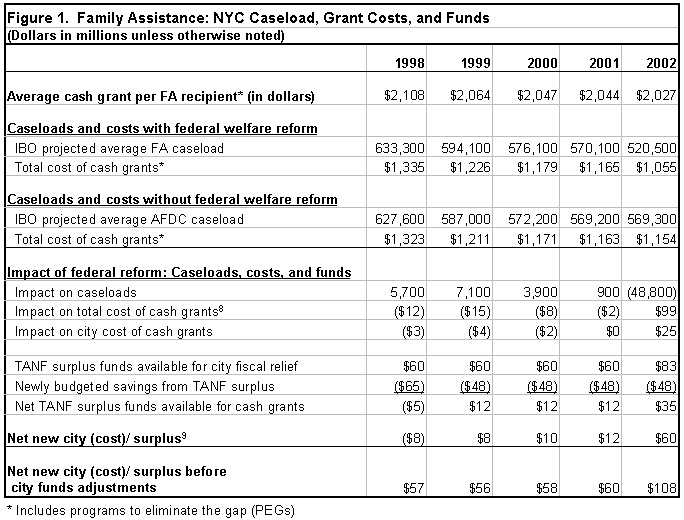
TANF
Funding for the new federal Temporary Assistance for Needy Families (TANF) block grant was authorized for the 1997 through 2002 period. TANF is distributed to states based on each state’s spending on public assistance programs in fiscal years 1992 through 1995.10 Because caseload levels in New York State have declined significantly relative to those base years, the state will receive more TANF dollars than are required to maintain the programs that were incorporated into the block grant, at least in the near term. This excess amount has frequently been referred to as the "TANF surplus." After calculating the expected surplus each year, the Governor and Legislature develop a plan to allocate it among various programs and jurisdictions, including the state government, New York City, and other local districts.
New York State has identified a TANF surplus of about $800 million for 1998 out of a total state allocation of $2.4 billion11 IBO estimates that New York City will receive approximately $272 million of these surplus funds:
- $64 million is available to cover work-related costs including employment and training programs and transportation for participants;
- $27 million has been budgeted for the city’s portion of the state child care block grant;
- $26 million is designated for programs required by the new state welfare law, such as drug screening, domestic violence screening, and a new case management pilot;
- $97 million funds a variety of child welfare and other programs; and
- $60 million can be used for fiscal relief, replacing some of the city funds that would have otherwise been spent on public assistance grants.
From the perspective of city officials, the term surplus is misleading, since a large portion of TANF money does not actually represent extra or additional program funding. The TANF surplus must be used for programs previously funded under the old welfare law and other old social service laws that were replaced by TANF and other block grants. Specifically:
- Of the $64 million in work-related funds, $24 million will be needed to cover current work program costs, leaving a potential net gain of $40 million. (See Figure 3.)
- The $27 million being transferred to the child care block grant may not actually result in a gain in child care funds flowing to the city if it is being used to replace state funding. (See the section on child care needs below.)
- The $97 million represents funds already expected under old funding streams to cover child welfare and social service programs.
- $26 million of the TANF funds coming into the city must be used to fund new programs mandated under state law.
There is a great deal of uncertainty involved in attempting to project the TANF surplus and its distribution in future years. Using our 1998 estimates, we assume a generally constant level of funding throughout the years of our analysis. The one exception occurs in 2002, when large numbers of FA recipients will reach their five-year limit and be forced to transfer to SNA. Since fewer recipients will be eligible for federal funds, the TANF surplus will increase significantly. IBO assumes that the city will receive its portion of the resulting TANF savings as additional fiscal relief.
Work Requirements
The city must fulfill a variety of mandates contained in the new federal and state welfare laws to implement its work programs for the Family Assistance population. Those requirements specify the acceptable types of work and training programs, the minimum hours of participation each week, and the proportion of adult recipients who must be engaged in those activities. Surprisingly, IBO’s analysis shows that the city has already exceeded federal work participation rate requirements and should have little difficulty continuing to do so.
The federal requirements contain two main elements affecting the number of recipients who must participate in work programs. First, states must meet minimum work participation rates—30 percent of all families receiving assistance for 1998. The rate increases in 5 percent increments each year to 50 percent for 2002. However, states that successfully reduce their caseloads from the 1995 base are given credit towards their participation rate. States failing to meet the rates face fiscal penalties. Second, the law mandates work activities for all recipients after two years of receiving benefits. Enforcement of this requirement would effectively override the stated work participation rates and accelerate the rate at which states must create work programs. Significantly, however, the law does not penalize states for non-compliance with this provision.
The new state law holds local districts responsible for fulfilling the increasing federal work participation rates. Failure to achieve minimum rates may result in districts incurring their share of any fiscal penalties assessed against the state for failure to achieve the federal quotas. Moreover, the state law requires all adult recipients of public assistance to be engaged in work activities "as soon as practicable." For adults receiving TANF-related funds this must be no later than 24 months after benefits begin. However, like the federal law, the state law does not penalize districts for non-compliance with this provision. The state allows exemptions from the work requirements for individuals who are ill, incapacitated, 60 years or older, teenagers in school, caring for an ill or incapacitated member of the household, women within a month of childbirth, and for a limited time, women with children younger than one year old.
The city’s ease in meeting federal work requirements is based on the new law’s credit for caseload reduction. The system of rising work quotas laid out in the federal law allows the city to claim credit against the work participation rate for reductions in the previous year’s caseload compared with the 1995 base. The extraordinary impact of this credit during a period of rapid caseload decline can be seen in Figure 2. For example, the average number of recipients in 1997 was 15.5 percent lower than the 1995 average. Therefore, the city’s effective overall work quota for 1998 is 14.5 percent of the caseload rather than 30 percent. Given our projections of FA caseload declines, the same pattern holds true for each year, with the city’s quota never rising above 17 percent.
As shown in Figure 2, achieving the federal work quotas would require the city to include only 28,500 cases in work programs in 1998 (14.5 percent of 196,400) and fewer in future years. The city already had adults from more than 49,300 cases participating in a variety of work activities qualifying under federal rules as of December 1997, which means that the city has achieved a Family Assistance work rate of 25 percent—well over its net minimum requirement.12 These include 17,233 recipients in the Work Experience Program (WEP), 6,335 in community service, 9,722 in unsubsidized employment, 5,234 in educational and employment training programs, 1,541 in job search, and 9,275 teenage family heads still in high school.13 Therefore, even if the city simply maintained its current work programs, it has already fulfilled its obligations under the federal work quotas.14
The other federal work requirement, the two-year rule, would ultimately require about 70 percent of adult recipients to participate in work programs, resulting in additional costs to the city of hundreds of millions of dollars.15 However, federal officials have made it clear that they will not penalize states for choosing to ignore this rule and IBO’s analysis is premised on the assumption that the two-year rule will not be enforced. Further, there are no provisions in the new state welfare law that would penalize the city for failing to increase its FA work participation rates beyond the rates specified in federal law.
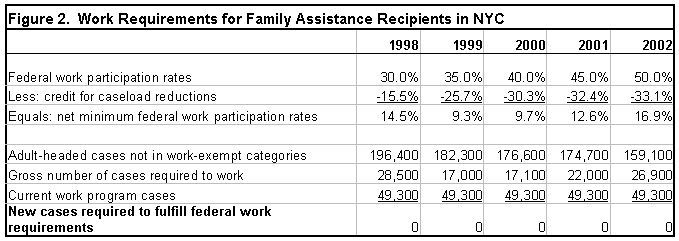
In sum, city officials have extraordinary freedom in designing any future Family Assistance work program. They can expand the current work program, freeze it at its current size or even shrink it a little and still satisfy federal law. In addition, work program participants beyond those required by the minimum federal quotas would not be bound by the minimum hours requirements or limitations on types of activities found in the 1996 federal law. Policy decisions can—and should—be made by weighing programmatic goals and their associated costs against available resources.
While the city has numerous options in creating work programs for public assistance recipients, it has begun to expand its current work program into a program of universal work participation. The program is discussed in more detail in the section, Universal Work Program Scenario, below.
Baseline Work Program Scenario: Family Assistance Work Program Costs
This section provides a work program model—a baseline work scenario—to analyze costs and funding associated with putting Family Assistance recipients to work, using the city’s current work program as a starting point. The analysis reveals that even a gradual expansion of the city’s current work program would drive program costs up by tens of millions of dollars over the next few years. However, the city will also receive additional work program funds that will more than offset the increases. The resulting surpluses point to significant financial flexibility—in addition to the legal flexibility described above—in the type of work program the city chooses to implement.
In its baseline work program scenario, IBO assumes that the city will gradually increase the FA work program to achieve a work participation rate of 35 percent in 1999 and 40 percent in 2000 and beyond. This scenario roughly corresponds to the policy followed by city officials until recently, one that emphasized a gradually expanding work program without attempting to achieve universal work participation. Figure 3 presents work program caseloads and cost information for this scenario.
The baseline scenario assumes that the Work Experience Program (WEP), in which participants perform labor for city agencies and city contractors as a condition of receipt of their welfare benefits, will continue as the centerpiece of the city’s work program.16 The projections of city administrative costs for new WEP workers are based on a reported cost of $700 per slot in 1997.17 Adjusting this figure for increasing hours of work per week, city collective bargaining increases, and transportation costs, IBO estimates annual city costs per worker will grow steadily over time to $838 in 1998, $1,146 in 1999, $1,206 in 2000, $1,237 in 2001, and $1,270 in 2002.18
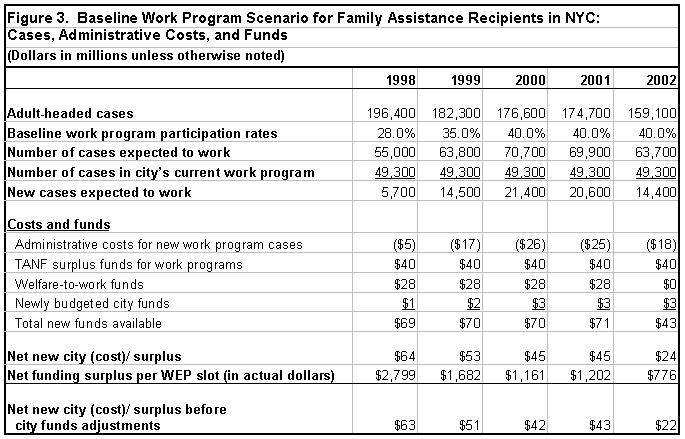
Given the work rates assumed in IBO’s baseline work program scenario, city policy would require nearly 64,000 FA cases to participate in work programs in 1999. After accounting for the 49,000 current participants, this would result in a need of about 14,500 new slots at a cost of almost $17 million (14,500 slots times $1,146). By 2000, the need would rise to 21,000 new slots at a cost of $26 million. As shown in Figure 3, however, those costs would be more than offset by newly available funds.
New funds would come from three sources. The first source is the portion of the TANF surplus IBO expects will be available to support the city’s work program for FA recipients—$40 million each year. Another source is the new federal Welfare-to-Work formula grant program that will support state work programs. Those funds will be provided in two installments and may be spent over four years. In order to receive the funds the state and city must identify one dollar in combined matching funds for every two federal dollars, but matching funds do not necessarily require new state or city spending. Our estimate assumes New York City will receive its maximum allocation of $113 million over two years and spend the funds evenly over the allowable four-year period.19 The third source includes modest amounts of city funds added as part of the city’s fiscal year 1998 budget in anticipation of the need to expand the number of WEP slots.20 When these three funding sources are combined, the city has about $70 million available each year through 2001.
Applying those funds to the city’s baseline work program costs would result in work program funding surpluses ranging from $45 million to $64 million each year through 2001, as shown in the next to last line of Figure 3. The last line of Figure 3 indicates adjustments to city funds have changed the funding picture only slightly.
Dividing the city’s surplus funds (including city funds adjustments) by the total number of old and new WEP slots leads to an important conclusion: the city will have at least $1,100 in additional funds per slot available each year through 2001.21 If combined with funds already being spent on WEP slots, the city could experiment with other, more service-intensive work activity models—including education, job skills training, and job-retention support—that would cost more in the short run but might prove more effective in helping individuals to move permanently from welfare to work. Even more funding per work program slot would be available if city officials chose to implement a smaller program, which it has the legal and fiscal flexibility to do, than the one assumed in this scenario.
This flexibility should remain high through 2001. The fiscal outlook for 2002 is somewhat less favorable, primarily due to the scheduled expiration of the Welfare-to-Work program. In addition, as discussed below, the city will probably begin to face new work program costs for Safety Net Assistance, as the five-year limit begins to shift families away from Family Assistance.
Child Care Needs Under the Baseline Scenario
New York City must provide for the child care needs of participating families to implement its work programs for Family Assistance recipients. This is no small task; the lack of affordable, quality child care in the city has resulted in tens of thousands of children on waiting lists for various types of subsidized care for much of 1998.22 According to state law, if mothers on public assistance who have been called to a work program can demonstrate that they cannot locate affordable and appropriate child care, they are legally exempt from being required to work.23 Therefore, the city’s work program is dependent on the provision of child care for participants.
Figure 4 presents the additional child care need, costs, and funds associated with IBO’s baseline work program scenario. After accounting for all previously funded child care slots, the city would be faced with a need of about 9,800 full-time equivalent (FTE) child care slots for work program participants in 1999, rising to about 15,500 slots by 2000. Based on the city’s policy of emphasizing low-cost, unlicensed (informal) child care for new work program participants, IBO estimates an average cost per full-time slot of $5,135 in 1998.24 Inflation and increased demand are expected to increase this unit cost to $6,479 by 2002. The resulting additional cost per year of providing these new slots would rise from $19 million in 1998 to $92 million by 2001.
Over the last two years, city officials have budgeted new federal, state, and city funds to cover the costs of child care for work program participants totaling $36 million in 1998 and increasing to $99 million in 2001. Under our baseline work scenario, when newly budgeted city funds are included, these additional funds more than cover new FA work program child care costs in all years except 2000, when a shortfall of $5 million occurs.25 The last line of Figure 4 shows that city funds adjustments have had a significant impact on the child care budgets for 1999 through 2002.
While budgeted child care funds now roughly cover the need generated by the baseline work program scenario, it is important to understand the broader child care funding landscape. Fundamentally, there is a great deal of uncertainty as to whether adequate state and federal funds for child care in general will materialize. Concern has arisen because the city has been receiving a disproportionately low share of child care funding from the state compared with its share of locally required child care spending. Moreover, by using more of the TANF surplus for child care needs, the state could increase the total amount of child care assistance it provides to local governments.
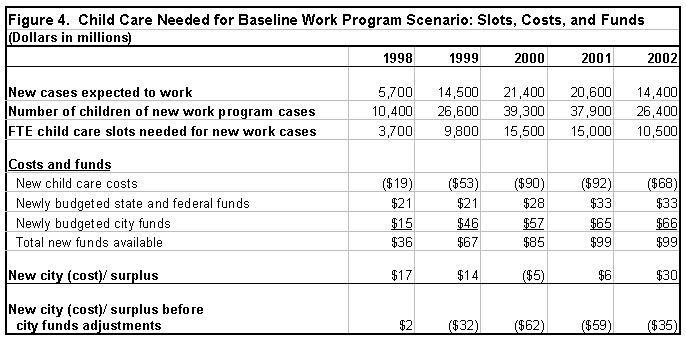
The state’s central role in controlling child care funds is due in part to dramatic changes in funding streams that have taken place over the past two years. The 1996 federal welfare law combined the various AFDC child care funding streams and the Child Care and Development Block Grant into a single block grant to states, called the Child Care and Development Fund (CCDF). New York State officials, in turn, combined this federal block grant money with various state child care funding streams and federal TANF surplus funds into a new state child care block grant. Each year, New York City and other local districts are assigned a portion of this large pool of child care funds. Districts use these funds to provide various types of subsidized child care, including slots and vouchers for public assistance work program participants.
In the first year of the state block grant, the city received 57 percent of the statewide total, for an estimated allocation of $167 million in state fiscal year 1997-98. That portion is far below the city’s 81 percent share of state child care spending (which is used toward the state’s matching requirements to draw down federal funds). In the adopted state budget for state fiscal year 1998-99, the city’s allocation from the state block grant increased by about $11 million, giving the city 53 percent of the statewide total. Not only is the allocation still inadequate in relation to the city’s proportion of child care spending; it is not large enough to cover the federal and state child care funding included in the city’s financial plan. As a result, city officials have recently moved to fill the overall child care funding gap in the city’s financial plan by replacing previously budgeted state and federal dollars with city funds.26
Increasing the flow of federal and state child care funds to the city would help the city achieve a more adequate and equitable level of funding. There are a number of ways in which this could be accomplished. First, the city could receive a larger share of the state block grant, thereby increasing funds for the city at the expense of other districts. An alternate solution would be to expand the statewide block grant. Under the federal CCDF, New York State’s child care allocation is expected to increase by more than five percent each year through 2002, as long as the state meets its matching fund requirements. Thus, the state block grant could increase each year, allowing the city to receive greater child care assistance without penalizing other districts. Finally, additional federal funds are available through the TANF surplus and the state could significantly increase the portion allocated for child care. The state has allocated about seven percent of all TANF surplus funds for child care needs over the past two years.27 With the state planning to set aside $218 million of the TANF surplus for unspecified contingencies, some of those funds could be used to expand the child care block grant.
Legal Aliens
The 1996 law placed significant new restrictions on the eligibility of most legal aliens for federal assistance, making a distinction between aliens in this country prior to August 22, 1996 (current aliens) and new aliens who arrive after that date. Typically, current aliens were banned from receiving SSI or food stamps. Non-exempt new aliens became ineligible for SSI, food stamps, federal Medicaid, and TANF-funded programs such as New York State’s Family Assistance. The 1997 federal budget agreement restored SSI eligibility for current aliens, though not for new aliens, saving the city approximately $50 million annually in costs associated with shifting this population to Safety Net Assistance. However, under state law, new aliens must be covered under SNA and city- and state-funded Medicaid.
Figure 5 shows new aliens’ coverage under SNA will increase costs to the city over time. These costs will be modest at first, but will rise each year as new waves of immigrants arrive in the city and change its demographic profile. The number of new aliens needing Safety Net Assistance due to their ineligibility for Family Assistance or SSI is projected to rise from about 7,000 in 1998 to 27,000 in 2002. The new city SNA and local Medicaid costs of providing for those no longer eligible is expected to rise from $18 million in 1998 to $73 million in 2002. After accounting for expected additional state funds, ranging from $7 million in 1998 to $28 million in 2002, the combined city cost for providing SNA grants and Medicaid for this population is expected to rise from $11 million in 1998 to $45 million in 2002.
Safety Net Assistance
Much of the projected cost to New York City of recent federal and state welfare reform comes from shifting individuals from the federally funded FA and SSI programs to state- and city-funded Safety Net Assistance. Even though the 1997 federal budget agreement restored SSI benefits to some legal aliens, the city is still faced with new SNA costs for more recent immigrants who are no longer eligible for federal programs, as well as for families who reach the five-year limit on Family Assistance.
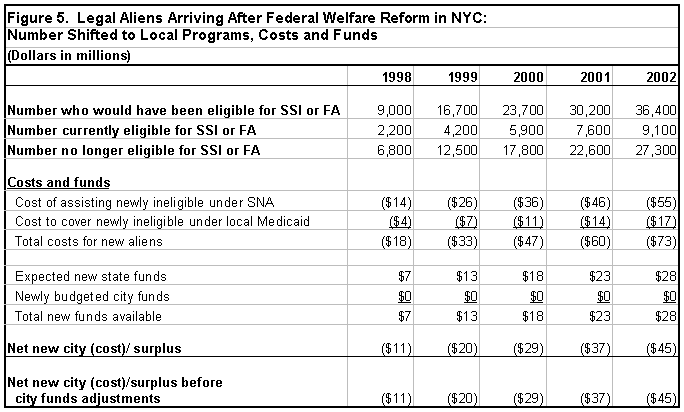
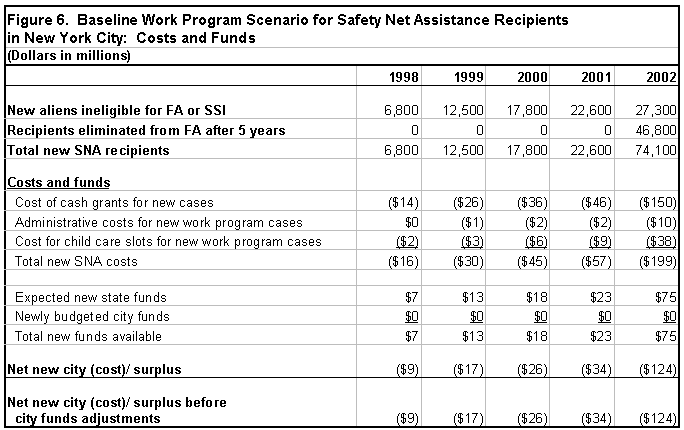
Figure 6 summarizes new SNA-related city costs. IBO projects that the total number of new SNA recipients attributable to federal welfare reform will rise from 6,800 in 1998 to 74,100 in 2002, when thousands of recipients will become ineligible for FA due to the five-year limit. In addition to cash grants, the costs include projected work program and child care costs for recipients.28 The total costs of new SNA cases is expected to more than triple to $57 million over the next three years before rising even more steeply to $199 million in 2002.
After accounting for expected new state funds, net new city costs are expected to rise gradually from $9 million in 1998 to $34 million in 2001. In 2002 city costs jump to $124 million, primarily due to the addition of 46,800 recipients whose FA eligibility will expire. This includes $75 million in grant costs (net of new state funds), $10 million for work program administration, and $38 million for child care.
Total Net Fiscal Impact
Figure 7 summarizes the fiscal impact of welfare changes imposed by the landmark federal welfare legislation of 1996 and its implementation by the city and state—before and after city funds adjustments that have already been made in response to these new laws. The figure, which brings together analyses developed in the previous sections, shows that until 2001, the city has more than enough funds available to remain flexible in the types of work programs it requires of public assistance recipients. However, the city must anticipate a funding shortfall in 2002.
Under IBO’s baseline work scenario, costs to the city from federal and state welfare reform implementation are expected to rise steadily from $47 million in 1998 to $278 million in 2002. However, new funding will more than offset these costs in every year but 2002. In 1998, there is a net city gain of $61 million, falling to $15 million in 2001.
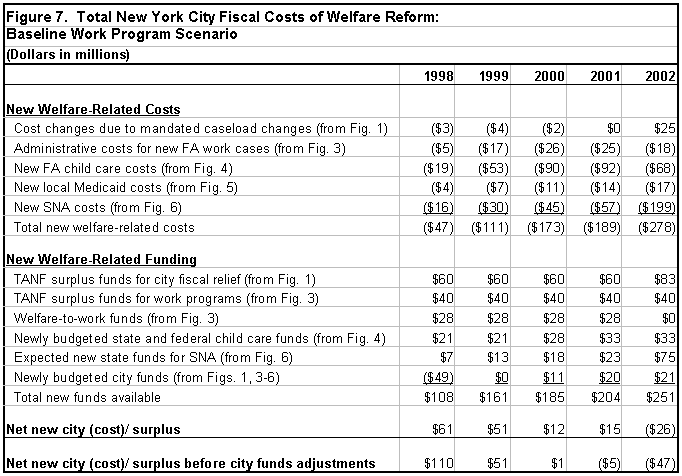
The situation in 2002 and beyond is far less favorable. As the full effects of the five-year limit on TANF recipients begin to take effect, net city costs rise to $26 million. In addition, assuming TANF funds will be authorized beyond 2002, new funding levels are likely to be much lower since they will likely be based on radically reduced caseloads.29
The last line of Figure 7 shows the net fiscal impact on the city, excluding all city funds adjustments that have been made in response to the new federal and state laws. As explained earlier, over the last two years the city has made several changes to its financial plan in recognition of new needs for work program administration and child care, and the use of TANF surplus funds for fiscal relief. The figures indicate decreasing surpluses in the first three years, and shortfalls of $5 million in 2001 and $47 million in 2002.
The relatively optimistic fiscal scenario shown in Figure 7 is based on assumptions that may not hold up, however. State officials could fail to provide New York City with adequate funds, particularly for child care. An economic downturn could increase welfare caseloads to levels well above those currently projected, significantly increasing the number of recipients who will need to be included in work activities and child care programs (see appendix). Finally, city officials could choose to push work participation rates to levels higher than the 40 percent assumed here, adding significantly to work program administration and child care costs. This possibility is discussed in greater detail below.
Universal Work Program Scenario
In the last few months, city officials have begun to implement major policy changes to convert their work program for public assistance recipients into a universal work program. IBO projects that establishment of a universal work program would add substantially to the city’s cost of welfare reform.
The new universal work program would mean few recipients would be exempt from a work requirement, regardless of obstacles which until now have been recognized as serious barriers to employment. The policy changes are likely to have far reaching social and economic impacts not only on public assistance recipients and their children, but also on low-wage private employment, city government employment, and the output of government services. As stated earlier, a major obstacle to analyzing potential impacts is the lack of available data. The city has made little visible effort to collect data regarding the outcomes of public assistance recipients who are leaving the rolls, or the employment and poverty status of those individuals who may be poor enough to qualify for benefits but who are now discouraged from applying due to more stringent administrative and programmatic demands. It is important for the city to gather and report key indicators of wages, family income, child well-being, and related conditions for those who have left welfare or been diverted from applying by city procedures. This information is essential to assessing the long-run social and fiscal effects of city policies.
While many details about the new plan have not been made available, the basic outlines have been articulated. These include:
- a universal work requirement with exemptions only for the severely disabled;
- an emphasis on job search and placement in unsubsidized employment;
- the conversion of income maintenance centers to job centers to underscore this new employment effort; and
- the expansion of WEP to cover all eligible recipients who cannot immediately find a job.30
The new program is to be fully phased in by calendar year 2000. At that point, all family heads receiving assistance will be required to participate in a full-time, 35 hour work week, usually including 20 hours of actual work and 15 hours of training or other activities—leading to the "earliest possible full-time private employment."31
IBO has developed a universal work program scenario in order to get a sense of the potential fiscal costs to the city. This scenario assumes city officials will succeed in achieving universal work program participation by December 1999. In keeping with stated city intentions, our definition of universal participation excludes only the severely disabled.
IBO’s universal work program scenario assumes that the new city policy will reduce the FA caseload by an additional 100,000 recipients beyond the reductions projected in our baseline work program scenario by increasing administrative requirements that divert some potential recipients from joining the rolls and remove others through sanction, and by encouraging adult recipients to find unsubsidized employment.32 Similarly, IBO assumes that the SNA caseload will be reduced by an additional 30,000 recipients. These additional FA and SNA caseload reductions are expected to occur by December 1999. Additional reductions beyond this point should be more difficult to achieve, as both the FA and SNA caseloads become not only smaller but increasingly needy and difficult to place in unsubsidized employment.
The impact of this work program expansion on fiscal costs is summarized in Figure 8. Despite the assumption of sharp declines in welfare caseloads, it is clear that a work program expansion of this magnitude would add substantially to the city’s cost of implementing welfare reform. For Family Assistance, the implementation of universal work participation would require the addition of 92,000 new work program slots by 2000, at a cost of $138 million. This work program expansion would in turn result in the need for 92,000 new child care slots at a cost of $615 million.33 For Safety Net Assistance, 61,000 new work slots and 3,600 child care slots would need to be added by 2000, resulting in total new costs of $123 million.
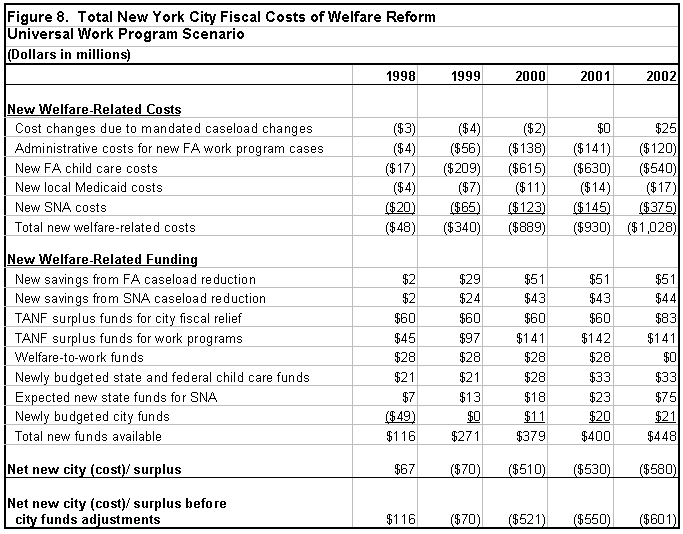
Some of these costs could be offset by new savings resulting from the additional caseload reductions likely to result from the new employment policy. As shown in Figure 8, the new caseload reductions assumed in our accelerated work scenario would result in significant reductions in public assistance grant outlays. Direct city spending on grant costs would be reduced by $51 million for FA and $43 million for SNA. In addition, since the state’s TANF surplus is calculated by subtracting the amount of TANF funds needed to cover cash grants to FA recipients from the state’s TANF block grant, reduced spending on cash grants would increase the surplus. IBO projects that the FA reductions would add about $100 million annually to the TANF surplus by 2000. We assume that state officials would return savings from FA reductions to the city to help defray work program costs—an optimistic assumption. Thus, the city could have about $200 million in new surplus funds available annually to help pay for the cost of expanded work participation.
However, even with a reduced caseload and additional funds, implementation of universal work participation would result in significant net costs to the city, rising from $70 million in 1999 to $580 million in 2002. As shown in the last line of Figure 8, excluding city funds adjustments that have already been made shows the net cost to the city to be $521 million in 2000, $550 million in 2001, and $601 million in 2002 under this scenario.
Conclusion
The passage of the 1996 federal welfare reform law and the 1997 state implementing legislation have brought about major changes in welfare policy, affecting basic decisions on program eligibility, work activity, child care, and funding sources. While important decisions remain to be made, it is clear that New York City has far more legal and fiscal flexibility in implementing welfare reform than it appeared to have two years ago–at least in the short run.
Due in large part to decreases in the FA caseload, the city should be able to satisfy federal work quotas merely by maintaining the current number of work program participants. This provides city policy makers with a myriad of options in deciding the size of its work program as well as the types of activities that will be included. Available funding would also enable the city to move away from the WEP model and towards more service-intensive alternatives for many participants. These alternative models will become more important as the shrinking caseload becomes increasingly made up of individuals who are very needy and hard to employ.
In spite of the options available to local policy makers, city officials have indicated their desire to mandate work program participation for all but the most severely disabled. Implementation of current plans for universal participation would add hundreds of millions of dollars in new costs for program administration and child care. The social and economic returns from the new policies are questionable and uncertain.
Whether universal work participation is fully implemented, two other factors could still increase the fiscal risk to the city in implementing welfare reform. First, state officials could fail to provide New York City with adequate state and federal funds, particularly for child care. Second, a significant economic downturn could increase the caseload size, leading to the need for additional funds for grant costs, work activities, and child care. The appendix to this report examines the scenario of higher caseloads due to local economic difficulties.
Appendix:
Higher Caseload ScenarioThe evidence presented thus far has made it abundantly clear that actual and projected decreases in welfare caseloads have greatly lowered the expected costs of implementing welfare reform. A reversal in caseload trends would send costs moving upward. In this section we will attempt to measure the fiscal impact of welfare reform in an era of rising caseloads.
To measure the sensitivity of costs to changes in caseload, IBO has developed a higher caseload scenario, based on the occurrence of a national economic recession leading to city job losses of the magnitude of those experienced in the early 1990s. Under this scenario, New York City employment would contract beginning in 1999 and employment losses would peak at over 300,000 in 2002. A local economic contraction of this magnitude is very unlikely to occur, but such a scenario is useful to measure the potential risk to the city. IBO projects that this type of economic downturn would result in an increase of more than 150,000 in the number of persons on FA, compared with our baseline projections. Average annual caseloads are projected to reach 614,000 in 1999, 663,000 in 2000, 717,000 in 2001, and 679,000 in 2002. Aside from this increased caseload, all other assumptions contained in our baseline work program scenario are maintained.
The impact of these caseload increases on costs is summarized in Figure 9. By 2002 city costs would reach $397 million, an increase of $119 million compared with the baseline scenario. The higher caseload also would have a significant impact on the funding side, greatly reducing the amount of TANF surplus available to the city since an increase in grant costs would reduce the surplus. The result would be a net cost to the city reaching $268 million by 2002. Excluding city funds adjustments already made, the net cost to the city by 2002 would be slightly higher—$289 million.
If the city implements a program of universal work, the additional costs resulting from a caseload increase would be significantly higher and come on top of the more than $500 million in new costs we have identified in Figure 8.
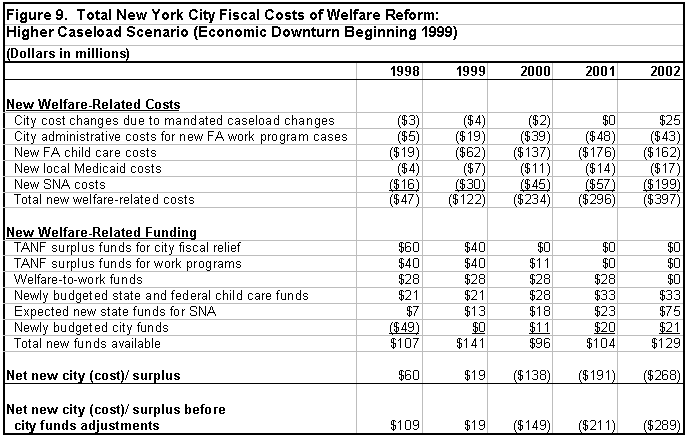
FOOTNOTES
- While the current block grant to New York State is known for each of these years, grants after 2002 will not be determined until the act is reauthorized by Congress.
- Initiatives have included Eligibility Verification Review, mandatory fingerprinting, and mandatory work activities for increasing numbers of recipients.
- Unless otherwise specified, all references to years in this report refer to federal fiscal years. Federal fiscal year 1998 runs from October 1, 1997 to September 30, 1998.
- The Mayor's 1999 executive budget projects that the FA caseload will sink even lower, reaching an average of 634,000 persons in federal fiscal year 1998, 585,000 in 1999, 555,000 in 2000, and 548,000 in 2001.
- Our caseload projection assumes the city's economy will continue to grow steadily through 2002. See the appendix for a higher caseload scenario associated with a downturn in the city's economy.
- A recent survey by the State Office of Temporary and Disability Assistance indicated that only 22 percent of families who dropped off the rolls in March 1997 and 31 percent who dropped off the rolls in March 1996 showed at least $100 in earnings in the following three months. Local Districts and State Performance Measures, Quarterly Report, Volume 6, January 1998.
- Our estimate assumes that the state will exempt, as it is allowed to under the current law, the maximum number of households, 20 percent of the total, from the five-year limit based on hardship. This assumption reduces the proportion of households reaching the time limit from 31 percent to 11 percent. If the state chooses not to exercise its exemption option, the number of recipients cut off from FA will be 175,000.
- In all figures in this report, costs are shown using parentheses, as are savings that have already been budgeted by the city.
- In this report, net costs are provided at the bottom of the tables in two ways, first by including the amount of changes in city funds that have occurred in response to federal welfare reform and second by excluding changes in city funds. When new city funds are included in the calculations, the resulting cost figures measure the unmet funding needs created by federal welfare reform. Cost figures that exclude city funds adjustments (last line in the tables) measure the cost to the city prior to a consideration of what the city has done to meet that cost.
- TANF incorporates into one block grant funds formerly budgeted through separate appropriations for the AFDC grant program, AFDC administrative costs, Emergency Assistance to Families (EAF), and the Job Opportunities and Basic Skills Program (JOBS).
- The state's calculations of the expected TANF surplus assume a growing economy and continuing caseload declines.
- The 25 percent figure is calculated by dividing 49,340, the number of cases with qualifying participants, by 196,381, the average number of adult-headed cases not in work-exempt categories for 1998. The NYC Human Resources Administration reported a December 1997 federal work participation rate of 29 percent. This suggests that HRA has assumed a higher number of individuals falling in work-exempt categories, which yields a smaller number in the fraction's denominator.
- New York City Human Resources Administration December 1997 work participation enrollment, as reported in a March 13, 1998 letter from Commissioner Jason Turner to the City Council General Welfare Committee.
- In addition to the overall work quotas, districts must achieve the specific federal quotas for two-parent families, which reach 75 percent for 1998 and 90 percent thereafter. A case qualifies if one parent is working. In the case of two-parent FA families, the city can receive credit for caseload decreases for this sub-population compared to the 1995 base. Based on statewide information, IBO estimates that New York State should have little difficulty achieving its net two-parent quotas without expanding its work programs.
- New York City Independent Budget Office, October 31, 1996, The Fiscal Impact of the New Federal Welfare Law on New York City.
- This model assumes all new work program participants in 1998 to 2002 will become part of the WEP program as opposed to other allowable activities such as job search or educational programs.
- Human Resources Administration, letter to the City Council Committee on General Welfare, April 24, 1997.
- These unit costs are significantly lower than those assumed in IBO's 1996 report which were based on a comparative analysis of work programs in other cities and assumed a more service-intensive program than is currently provided to individuals who participate only in WEP. IBO's previous estimate that an upgraded work program could cost approximately $2,250 a year was corroborated by a separate study, Welfare Policies for New York State: Recommendations by the Task Force for Sensible Welfare Reform, June 1997.
- In addition to the formula grants shown in Figure 3, the city can also apply for Welfare-to-Work competitive grants. In May 1998, two NYC nonprofit groups were awarded approximately $10 million to develop new work programs for FA recipients. Those funds may be spent over three years.
- No additional public assistance work program funds were added to the Mayor's Fiscal Year 1999 June financial plan or the city's adopted budget for fiscal year 1999.
- Old WEP slots refers to the 17,233 participants as of December 1997; new WEP slots refers to all additional work program participants estimated for each year 1998 through 2002.
- Child care for welfare recipients should be viewed in the context of the current provision of and need for subsidized child care for children of low-income working parents not on welfare. Resources for this group should not be reduced to cover welfare-related child care needs.
- The law applies for children under age 13 and includes exemptions for parents with older children with disabilities.
- IBO's cost projection for 1998 is very similar to the estimate presented in the 1998 executive budget. The city's estimate—$5,118 for new full-time day care slots for FA recipients in work programs—assumed a mixture of 71 percent unlicensed and 29 percent licensed slots. The current average annual cost per slot at the city's Agency for Child Development is $6,500, reflecting a different mix of child care types and more emphasis on licensed care.
The extent to which the city should rely on participants using unlicensed, unregulated child care, rather than more reliable licensed child care, is an important policy concern. The average cost per slot would rise if more participants could access licensed care.
- When combined with the new Safety Net Assistance child care costs discussed below, modest shortfalls occur after the first two years—totaling $11 million in 2000, $3 million in 2001, and $8 million in 2002.
- In his June 1999 financial plan, the Mayor replaced previously budgeted state and federal child care funds with city funds totaling $42 million in city fiscal year 1999, $54 million in 2000, $68 million in 2001, and $69 million in 2002.
- The state budget for 1997-98 allocates $45 million for child care statewide out of a TANF surplus of $825 million. The adopted budget for state fiscal year 1998-99 allocates $60 million for child care out of a projected TANF surplus of $708 million.
- In our projections, IBO assumes a city policy under which the proportion of new SNA families in work programs will equal that for FA families under the baseline scenario. Individuals shifting from SSI would be disabled and, therefore, excluded from workfare.
- Under federal law, current TANF block grant levels are authorized through 2002.
- New York City Human Resources Administration Commissioner Jason Turner, Testimony to the City Council Committee on General Welfare, March 25, 1998.
- Reaching Out to All New Yorkers by Restoring Work to the Center of City Life, a speech delivered by Mayor Rudolph Giuliani on July 20, 1998.
- This figure is a plausible estimate based on previous caseload declines, nationwide trends, and historical knowledge. It is not a prediction, nor is it the result of a model or formula. Instead, it is a tool to assess the potential impact of a universal work program.
- More than a third of these increased costs results from the requirement that recipients participate in work or training for 35 hours per week by 2000. In contrast, IBO's baseline scenario assumes the implementation of the federal minimum requirements, which reach 30 hours a week by 2000 for single parents with children of school age and 20 hours per week for single parents with children under six. In our universal work scenario, the increase in work hours alone accounts for about $200 million of the additional annual costs by 2000.